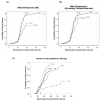Aging and fertility patterns in wild chimpanzees provide insights into the evolution of menopause
- PMID: 18083515
- PMCID: PMC2190291
- DOI: 10.1016/j.cub.2007.11.033
Aging and fertility patterns in wild chimpanzees provide insights into the evolution of menopause
Abstract
Human menopause is remarkable in that reproductive senescence is markedly accelerated relative to somatic aging, leaving an extended postreproductive period for a large proportion of women. Functional explanations for this are debated, in part because comparative data from closely related species are inadequate. Existing studies of chimpanzees are based on very small samples and have not provided clear conclusions about the reproductive function of aging females. These studies have not examined whether reproductive senescence in chimpanzees exceeds the pace of general aging, as in humans, or occurs in parallel with declines in overall health, as in many other animals. In order to remedy these problems, we examined fertility and mortality patterns in six free-living chimpanzee populations. Chimpanzee and human birth rates show similar patterns of decline beginning in the fourth decade, suggesting that the physiology of reproductive senescence was relatively conserved in human evolution. However, in contrast to humans, chimpanzee fertility declines are consistent with declines in survivorship, and healthy females maintain high birth rates late into life. Thus, in contrast to recent claims, we find no evidence that menopause is a typical characteristic of chimpanzee life histories.
Figures



Similar articles
-
Reproductive aging in captive and wild common chimpanzees: factors influencing the rate of follicular depletion.Am J Primatol. 2009 Apr;71(4):271-82. doi: 10.1002/ajp.20650. Am J Primatol. 2009. PMID: 19067363 Review.
-
Mortality and fertility rates in humans and chimpanzees: How within-species variation complicates cross-species comparisons.Am J Hum Biol. 2009 Jul-Aug;21(4):578-86. doi: 10.1002/ajhb.20890. Am J Hum Biol. 2009. PMID: 19213006 Free PMC article.
-
Menopause occurs late in life in the captive chimpanzee (Pan troglodytes).Age (Dordr). 2012 Oct;34(5):1145-56. doi: 10.1007/s11357-011-9351-0. Epub 2011 Dec 22. Age (Dordr). 2012. PMID: 22189910 Free PMC article.
-
Menstrual cycles continue into advanced old age in the common chimpanzee (Pan troglodytes).Biol Reprod. 2008 Sep;79(3):407-12. doi: 10.1095/biolreprod.108.068494. Epub 2008 May 21. Biol Reprod. 2008. PMID: 18495682 Free PMC article.
-
Reproductive potential in the older woman.Fertil Steril. 1986 Dec;46(6):989-1001. doi: 10.1016/s0015-0282(16)49869-9. Fertil Steril. 1986. PMID: 3536609 Review.
Cited by
-
Age-related decline in ovarian follicle stocks differ between chimpanzees (Pan troglodytes) and humans.Age (Dordr). 2015 Feb;37(1):9746. doi: 10.1007/s11357-015-9746-4. Epub 2015 Feb 5. Age (Dordr). 2015. PMID: 25651885 Free PMC article.
-
Healthy cardiovascular biomarkers across the lifespan in wild-born chimpanzees (Pan troglodytes).Philos Trans R Soc Lond B Biol Sci. 2020 Nov 9;375(1811):20190609. doi: 10.1098/rstb.2019.0609. Epub 2020 Sep 21. Philos Trans R Soc Lond B Biol Sci. 2020. PMID: 32951545 Free PMC article.
-
Demography, life-history trade-offs, and the gastrointestinal virome of wild chimpanzees.Philos Trans R Soc Lond B Biol Sci. 2020 Nov 9;375(1811):20190613. doi: 10.1098/rstb.2019.0613. Epub 2020 Sep 21. Philos Trans R Soc Lond B Biol Sci. 2020. PMID: 32951554 Free PMC article.
-
Evolutionary medicine: its scope, interest and potential.Proc Biol Sci. 2012 Nov 7;279(1746):4305-21. doi: 10.1098/rspb.2012.1326. Epub 2012 Aug 29. Proc Biol Sci. 2012. PMID: 22933370 Free PMC article. Review.
-
Cooperative breeding in South American hunter-gatherers.Proc Biol Sci. 2009 Nov 7;276(1674):3863-70. doi: 10.1098/rspb.2009.1061. Epub 2009 Aug 19. Proc Biol Sci. 2009. PMID: 19692401 Free PMC article.
References
-
- Hill K, Hurtado AM. Ache Life History: The Ecology and Demography of a Foraging People. Aldine de Gruyter; New York: 1996.
-
- Pavelka MSM, Fedigan LM. Menopause: a comparative life history perspective. Yearb. Phys. Anthropol. 1991;34:13–38.
-
- Williams G. Pleiotropy, natural selection, and the evolution of senescence. Evolution. 1957;11:398–411.
-
- Alexander R. The evolution of social behavior. Annu. Rev. Ecol. Syst. 1974;5:325–383.
-
- Hawkes K, O'Connell J, Blurton Jones N. Hardworking Hadza grandmothers. In: Standen V, Foley R, editors. Comparative Socioecology: The Behavioural Ecology of Humans and Other Mammals. Blackwell Scientific Publications; Oxford: 1989. pp. 341–366.
Publication types
MeSH terms
Grants and funding
LinkOut - more resources
Full Text Sources
Medical

